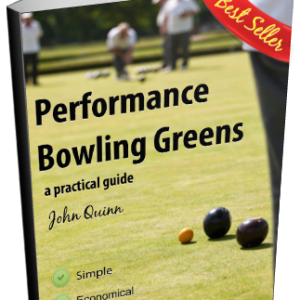- Top dressing is counter productive to producing a Performance Bowling Green
- Following the Performance Bowls Green system reduces maintenance costs from day 1.
- Doing too much work on your green can be detrimental to its condition.
- The performance greens program has the long term effect of reducing the work needed on the green.
- Performance bowls greens can be maintained with zero pesticides, another saving.
Author: John
Master Greenkeeper John Quinn is the author of Performance Bowling Greens, and several other titles on Greenkeeping, Club and Business Management.
Preventative fungicide
The agronomic advice received by many clubs with regard to winter maintenance is just wrong and no where is this more prevalent than in the advice given about fungal disease prevention.
A healthy, living soil contains many different types of fungi and only a few of them are potentially harmful to the green.
If the green and soil are maintained in a healthy condition, even the potentially harmful fungal pathogens like fusarium, take all patch, dollar spot, anthracnose etc, although probably still present, pose no real threat to the turf.
The soil under your green when in its natural state is a little eco-system all of its own and the balance of this eco-system is easily destroyed by clumsy maintenance practices.
Soil micro-organisms and all manner of beneficial fungi need to thrive under there to make your green work the way it should i.e. to a high standard with the minimum of chemical intervention. Beneficial soil fungi actually work with grass plants to help them take up essential nutrition from the soil.
For this reason, even a green that is knackered and at the very beginning of the Performance Greens turnaround process should not be subjected to blanket applications of any fungicide.
This is because broad spectrum fungicides are pretty blunt instruments and don’t differentiate between good and bad fungi, meaning that every blanket application is essentially turning your green away from the door at the Performance Greens Annual Dance!
The whole process of decline in greens due to “traditional” maintenance is detailed here.
The recovery process is outlined here.
One reader told me of his recent bill for fungicide totalling over £800; for a tiny fracftion of that money you can get yourself a map out of this madness here.
5 warning signs that your bowls green is dying
Many bowls greens have problems; its rare for a season to go by with only praise for the green from members.
The majority of the problems encountered on bowls greens is directly attributable to the maintenance the green gets and the in particular the maintenance it has had over the years, especially the last 4 decades.
This is due in large part to the traditions that have taken hold in bowls green keeping that are wholly inappropriate to maintaining the green in a state of high performance.
There are many warning signs that your green is suffering but these 5 are the main ones that you should be aware of:
- Foot prints on the bowls green surface; if you regularly leave indentations with your feet on the green surface this is a sign that there is too much thatch building up. Thatch inhibits health by reducing access for oxygen into the green surface. Thatch also harbours fungal disease spores and can be a precursor to severe localised dry patch outbreaks.
- Yellowing leaves on grass plants; this is another sign that all is not well with the health of your bowls green and the soil underlying it. Yellowing or chloritic grass plants means that the turf is suffering from a lack of essential nutrients, or that the soil is lacking oxygen which is essential for the encouragement of beneficial soil microbes. There are many other reasons that grass plants could exhibit yellowing leaves, including fungal diseases but all of the possible reasons point to underlying problems with the green’s turf/soil relationship.
- The bowls green surface is unpredictable to play on; when a bowls green is unpredictable to play on from day to day or from rink to rink; sometimes slow, sometimes fast and with quirky draws this is a sign of underlying problems which could include localised dry patch, excessive thatch and compaction.
- Green surface looks patchy; again a patchy looking green, which has varying degrees of turf density, bare patches, weeds, moss or other grasses is usually suffering from a lack of soil oxygen and a low soil microbe population.
- Puddles on green surface after rain; this can be caused by excessive thatch, compaction or localised dry patch which causes the green surface to become hydrophobic or water repellent.
Problems such as these cannot and should not be dealt with on a piecemeal basis. All of these problems are simply symptoms of underlying issues. The decline of bowls greens is described in detail here and the answer to the problem is detailed here.
7 Ways to Grow your Bowls Club Membership
Growing bowls club membership is often considered impossible or at least very difficult.
The most likely sources of new members for your club are the existing members, their contacts and your local community.
My eBook “Bowling Club Membership, retention and growth” includes a vast number of tactics you can use to build the popularity of your club. Here are 7 for starters:
1. Add value to membership; make it a sought after commodity.
2. Cast your net wider than just the bowling community.
3. Adopt a culture of Continuous Improvement.
4. Create different Membership types
5. Ask your Members how you are doing and what they would like to see.
6. Open your facilities to local groups
7. Interact on a professional basis with your local business community.
Bowling Club Membership Retention and Growth details a step by step a strategy for uncovering a huge un-tapped resource of potential members and income for your club.
Use this Coupon Code at the checkout to get it for half price: “member50”
Bowls and Buddhism
Listening to the national news either on the radio in the car or on TV, it seems that we are at the height of summer and everyone is still on holiday.
Of course this pretty much is the case for a large proportion of the UK population, but here in Perthshire I can reveal that it is Autumn or very close to it. The kids have all been back to school for 2 weeks and the farmers are planting their over wintering crops. There has been heavy dew on the grass in the mornings, at least when it hasn’t been raining!…and this morning a heavy mist hung low over the fields.
This serves as a stark reminder that it is time to arrange the work for the Autumn renovation program on the bowling green, regardless of how summery you are feeling.
As an aside I was watching a program about Buddhism last night and was reminded that the Buddhist strives to reach a state known as “Nirvana” in his or her life. However, the presenter recognised that there were many different views among the Buddhist community about what “Nirvana” was.
This set me thinking about what Nirvana would look like for the average UK bowling club; and unlike last nights presenter I was able to put my finger right on it:
Nirvana = a consistently high performance bowling green and a thriving, financially secure club.
Now for the hard bit; how do we achieve Nirvana in our bowling clubs?
Well in a short post like this I can’t even start to cover all of the how’s, where’s, what’s and why’s of trying to reach this state, and anyway this has been set out in great detail in Performance Bowling Greens and Bowling Club Survival and Turnaround, but I can give very concise advice on how to get started on both parts of this ultimate goal this autumn:
Cancel the Top Dressing Order.
How will this help your club on its way to Nirvana?
- It will leave £1000 or more in the club coffers that would otherwise have gone towards perpetuating the folly that many many clubs have bought into over the last two decades.
- It will start you off on the road to creating a healthy, living, high performance green. If you are new to the site, type “top dressing” into the search box at the top of the page to get further comprehensive advice on this subject.
Over the next week we will be adding a heap of new free resources to the Members area to help with Autumn and Winter projects on the green and in the club.


